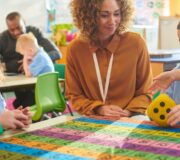What Is Fluency In Maths & How Do Schools Develop It?
Experienced maths lead and Third Space Learning user, Rebecca Jakes, gives a clear definition of what fluency in maths means, what fluency looks like within a mastery curriculum, and, crucially for other primary teachers, proven techniques and resources that she has seen develop fluency at Key Stage 2.
When the new national curriculum was introduced in 2016, its triple emphasis on maths fluency, reasoning and problem solving, caused a sharp intake of breath amongst teachers and leaders nationwide.
Overall, the higher expectation alongside introducing a new curriculum for mastery and depth was quite daunting at first. How would the children cope? How would teachers cope?
Maths fluency was central to this new form of mathematics education. What did it mean, how should we teach it, and would children achieve age-related expectations by their KS2 SATs?
A few years down the line, I’ve recently found myself reflecting on these changes from the vantage point of being a maths leader and adviser across several schools. I’ve assessed which interventions and initiatives we’ve used that have truly developed pupils maths fluency at KS2.
What is fluency in maths?
Fluency in maths, or maths fluency, means developing number sense and being able to choose the most appropriate method for the task at hand; to apply a skill to multiple contexts.
The national curriculum states that pupils should become fluent in the fundamentals of mathematics through varied and frequent practice.
While part of this concerns knowing key mathematical facts and recalling them efficiently, fluency means so much more. It allows pupils to delve much deeper.
How does mathematical fluency fit with reasoning and problem solving?
The mastery curriculum for primary schools places problem solving at the heart of mathematics with the main aim that every child can solve sophisticated multi-step word problems in an unfamiliar context.
To enable them to achieve this, pupils must develop their conceptual understanding, mathematical thinking and use of mathematical language. This is where fluency and reasoning come in.
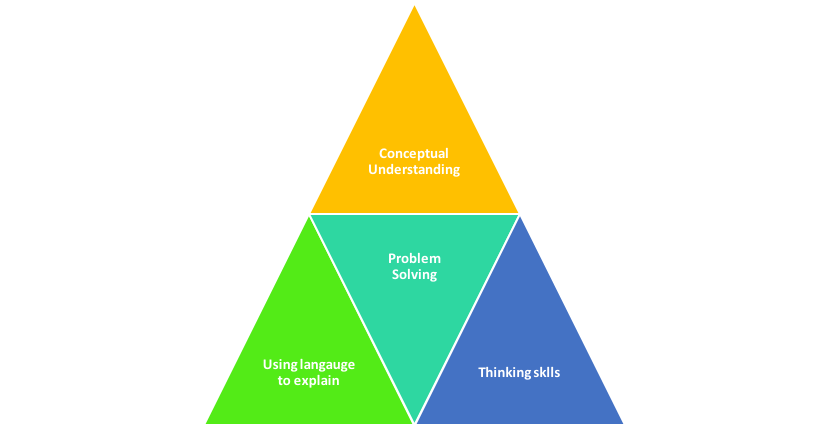
Fluent in Five Arithmetic Pack: Years 3 to 6 [Weeks 1 to 6]
Use on a whiteboard or print out our SATs style questions, complete with progression document & help for pupils to choose mental or written method
Download Free Now!How fluency and reasoning work in primary maths
Maths fluency works through intelligent practice rather than repetition or rote memorisation. Once a child grasps a mathematical concept, they should be exposed to varied fluency activities to develop their understanding.
These activities should require them to use verbal reasoning to justify and explain their thinking in order to solve word problems in an unfamiliar context.
Making this happen in the classroom is quite straightforward when you focus on the unit you are teaching.
However, we’ve all felt the frustration of giving children problems that include applying previously taught skills only to be met with blank faces.
So how are schools ensuring children improve learning and memory and don’t forget the basics as they move from one unit to another?
Simple – they are adding in some extra time every day or week to simply practise previously taught maths skills.

Meet Skye, the voice-based AI tutor making maths success possible for every student.
Built by teachers and maths experts, Skye uses the same pedagogy, curriculum and lesson structure as our traditional tutoring.
But, with more flexibility and a lower cost, schools can scale online maths tutoring to support every student who needs it.
Watch Skye in actionWhat is the best way to teach KS2 maths fluency?
A mastery curriculum means that children can practise until they can calculate confidently. Over the last couple of years, I’ve witnessed how truly beneficial this is for pupils.
Children are more fluent in calculations and times tables and they’re loving it!
Their fluency in calculations such as multiplication facts has led to pupils tackling more complex problems with greater confidence and resilience.
Children can put all their energy into how to solve their mathematical problem because they know how to do the calculations and the most appropriate strategy to choose each time.
As a primary teacher and consultant, I am fortunate to see the many different ways in which schools give children time to hone the skills needed through daily or weekly practice.
While there’s a lot of variation and different methods for tackling this, the one thing that is constant is that they are producing good or excellent outcomes in maths.
So what’s working?
Effective strategies for teaching maths fluency
Here are four different approaches to improving fluency in Maths at KS2 used by schools in my area.
Fluency strategy 1: mastery time
As maths leader at my previous school, Woodcot Primary, I introduced a set time each day of around 30 minutes of dedicated fluency practice using a carousel of activities.
During this time the class teacher works with a guided group to either:
- Review concepts with pupils who did not fully grasped it during that day’s lesson.
- Pre-teach target children.
- Work with target children on areas of arithmetic they are not yet fluent in.
The rest of the class work on the focus of the day. This is usually practising fluency in calculations or times table and related division facts.
In KS1 there is a heavy focus on number bonds and memorising number facts. Most classes have one day of the week where children practise using online or offline KS1 maths games to embed number relationships.
This approach has positively impacted pupil confidence in maths and resilience. As pupils gain fluency in calculations, they worry less about making mistakes and focus on unpicking sophisticated problems.
For Year 6 pupils, it’s greatly impacted arithmetic scores, leaving children plenty of time to develop the reasoning and problem solving skills needed for the KS2 SATs.
Fluency strategy 2: maths meetings
Haselworth Primary School hold daily ‘maths meetings’.
In KS1 these focus on counting (forwards, backwards, 2s, 5s, 10s etc.) in a fun context such as ‘counting tennis’. Pupils bat numbers back and forth with a partner. In Yeat 1 and 2, they focus on number bonds and quick recalls of doubles and halves.
READ MORE: 10 ways to memorise number facts at KS2
KS2 maths meetings focus on times table facts with daily practice and a weekly test. They also have a daily fluency activity based on agreed key fluency skills for each year group.
In addition to this, Year 6 do daily maths SATs facts from Vocabulary Ninja and Fluent in Five arithmetic practice from Third Space Learning.
Fluency strategy 3: weekly repetition
‘Number of the Week’ sheets are a common addition to fluency practice. The example here is from a Year 4 class at a school I recently moderated.
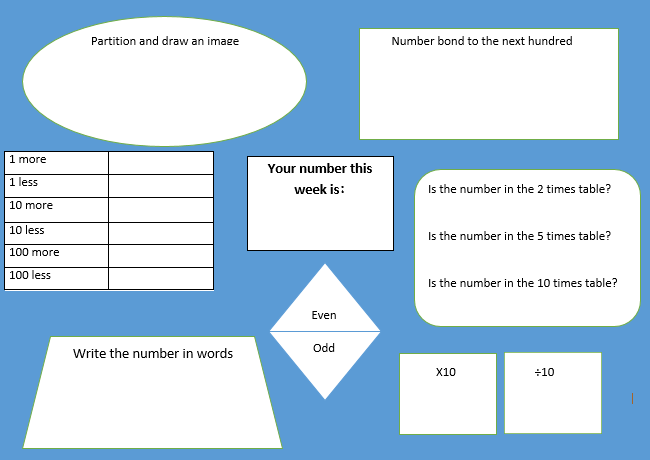
Teachers reported that the biggest impact was that pupils could visualise a number and its properties much more quickly in other contexts. And, pupils reportedly enjoy the familiarity of the activity.
Differentiate the sheet for different abilities or year group focus. Use concrete resources to support learning when necessary.
Fluency strategy 4: targeted fluency focus
At my new school Brockhurst Primary, each year group has a set fluency focus per half term.
During each half term, teachers provide fluency activities on a daily or weekly basis and ensure there are visual reminders around the classroom to bring it to the forefront of the children’s minds.
Every half term children take home a ‘Fluency in Maths: Key Facts’ sheet with one area to focus on. Parents become involved in learning and have a greater understanding of the expectations for their child.
By the end of the half term, children should know these facts and the aim is for them to achieve true automaticity and recall them instantly.
Many classes also hold a ‘daily maths mile’ where children walk or jog a mile while practising their area of focus as a class.
Maths fluency strategies to teach pupils for quick arithmetic
Addition and subtraction:
Rounding and adjusting

Round numbers up or down to closest multiple of 10, 100 or 1,000 to make calculation easier to do mentally. Then adjust the answer accordingly, if you add or subtract to reach a multiple, you must add or subtract that from your answer.
For example, 12 + 23 =
- Round 12 down to 10
- 10 + 23 = 33
- 33 + 2 = 35 (we subtracted 2 from the 12 to get to 10 so we must add it back to the answer).
Counting on to find the difference

If two numbers in a subtraction are close together, it can be easier to find the difference between them by counting up from the smaller number to the larger number than try and subtract them.
For example, 97 – 88 =
Count on from 88 to 97 rather than subtract 88 from 97.
Use the inverse

When numbers are missing in a calculation, we can often use the inverse relationship between addition and subtraction to help us find them. If we are missing a part in an addition calculation, we can subtract the part we know from the total.
For example, 38 + = 53 is the same as 53 – 38 =
Multiplication and division
Use known facts

If pupils are secure with multiplication and division facts, they can help use them to solve lots of related fact.
For example:
- If we know that 3 x 6 = 18, we also know that 30 x 6 = 180
- If we know that 45 ÷ 9 = 5, we know that 450 ÷ 9 = 50
Re-arrange numbers
Teach pupils to use the law of association when multiplying 3 or more numbers as the product will always be the same. This means pupils can multiply the numbers in an order they find easier.
For example, 8 x 9 x 5 = is the same as 5 x 8 x 9 =
Calculating with fractions
Find the lowest common denominator

When children add and subtract fractions, the denominators must be the same. Pupils can use any common denominator for this, but the most efficient strategy is to use the lowest common denominator wherever possible.
For example, \frac{1}{2} + \frac{1}{4} =
The lowest common denominator is 4 so \frac{1}{2} becomes \frac{2}{4}
\frac{2}{4} + \frac{1}{4} = \frac{3}{4}
Find one part and multiply

Multiply can also mean ‘of’. When multiplying fractions by whole numbers, pupils can think of this in the same way as finding a fraction of an amount. For example, \frac{2}{5} x 300 is the same as finding \frac{2}{5} of 300.
This means we can find one part by dividing the number by the denominator and then multiplying.
Multiply numerators and denominators

When multiplying two fractions together, the most efficient strategy is to multiply the numerators together to get the numerator of the new fraction and multiply the denominators together to get the denominator.
It is also useful to practise finding the simplest form of fractions once multiplied to keep the numbers manageable.
Use a multiplication

Dividing a fraction by a whole number is like finding a fraction of a fraction, which means we can use what we know about multiplying fractions to help us.
Turn the whole number into a unit fraction and then multiply the 2 fractions together. This makes it an easy calculation and also helps children understand the process of dividing fractions by whole numbers.
\frac{1}{3} ÷ 4 =
\frac{1}{3} x \frac{4}{1} = \frac{4}{3} = 1 \frac{1}{3}
Decimal calculations
Add placeholders

When decimals have a different number of decimal places and we need to do a tricky addition or subtraction, the easiest method can be to add placeholders so that the numbers have the same number of places. From there, we can use a written method to add or subtract.
Move the digits

When multiplying or dividing by 10, 100 or 1,000, encourage pupils to think about shifting the digits left or right.
Multiply whole numbers and scale

If pupils need to multiply a whole number by a decimal, it can be easier to multiply them both as whole numbers and then scale the answer.
For example, 1.4 x 28 =
Multiply 1.4 by 10 to get 14 x 28 = 392
Then scale our answer by dividing it by 10 = 39.2
Percentages
Find 10%

When finding percentages that are multiples of 10, such as 60% and 40%, divide the amount by 10 to find 10% and then multiply by the multiple of 10 to get the final amount.
For example, 40% of 30 =
10% of 30 = 3
3 x 4 = 12
So 40% of 30 = 12
Find 5 %
Children can find percentages that are multiples of 5 such as 45% and 35% by finding 10% and then halving to get 5%. We can then add this 5% on to the final answer.
For example, 35% of 60 =
10% of 60 = 6
5% = half of 10% so 5% of 60 = 3
6 x 3 = 18
18 + 3 = 21
So 35% of 60 = 21
Find 1% and multiply

If we need to find a percentage that is not a multiple of 10 or 5 (e.g. 4%, 8%), we can find 1% by dividing by 100 and then multiplying to get the final amount.
For example, 2% of 240 =
1% = 2.4
2.4 x 2 = 4.8
So 2% of 240 = 4.8
Use partitioning

When the percentages are difficult to find (e.g. 26%, 48%), we can partition them into amounts that are easier to work out and then add. For example, for 28%, we can find 20%, then we can find 8%, and then add the 2 amounts together.
Use subtraction

If the percentage is large (e.g. 98%, 99%), it can be easier to find 1%, multiply by how far away it is from 100. For example, to find 98%, find 1% and multiply by 2 to get the 2% and then subtract this from the number.
The best free resources to develop fluency in maths for Year 3, Year 4, Year 5 & Year 6
Finally, here are my recommendations for my top three engaging (and mostly free) resources to develop fluency in maths at KS2. They’re great for developing fluency in short bursts throughout the term.
1. Fluent In Five Daily Arithmetic Practice – Third Space Learning
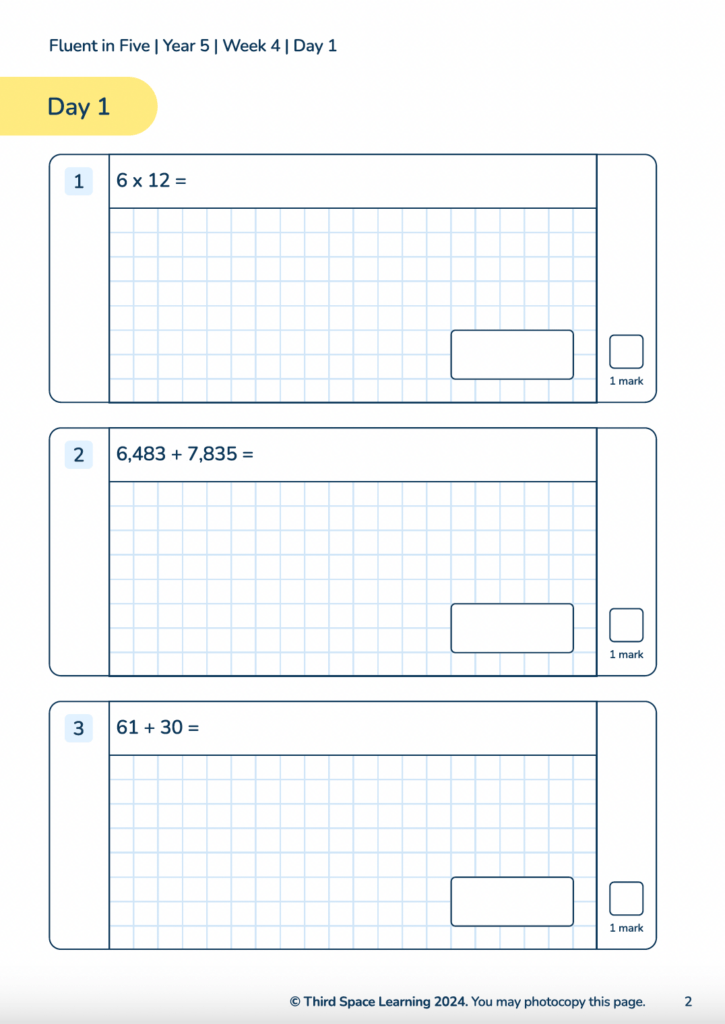
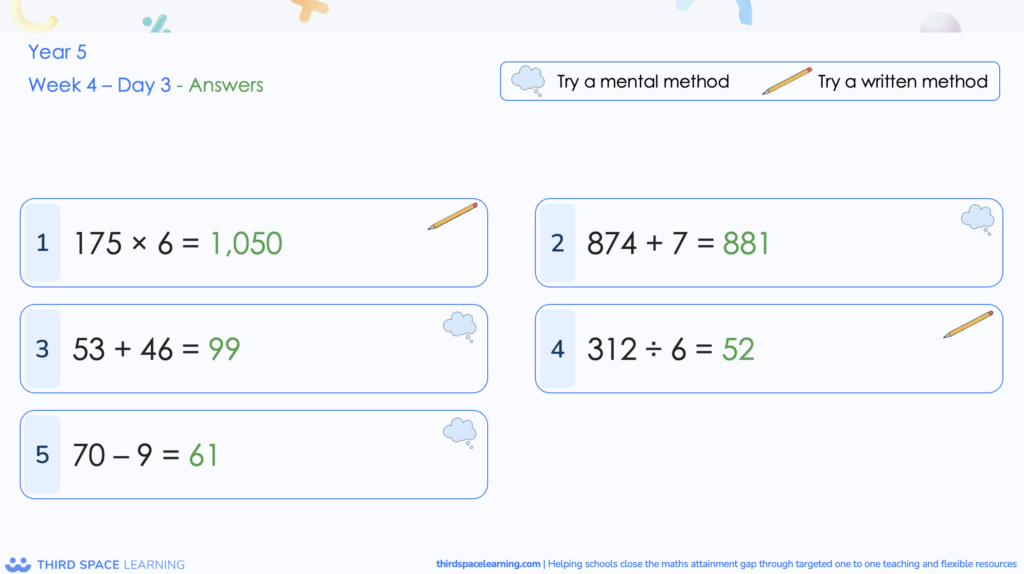
You can download weeks 1-6 for free here.
This free arithmetic resource is designed around the mastery approach, and the daily activities really do only take five minutes.
In Year 4, I use them as at the beginning of a lesson and find them brilliant for sharing ideas for mental calculations. They are particularly good for children who don’t make obvious links like number bonds and near doubles and are overly reliant on written methods.
For Years 5 and 6 they provide an opportunity to practise arithmetic fluency on a daily basis, and offer the perfect chance for teachers to address misconceptions or set arithmetic targets.
The other advantage of Fluent in Five is the emphasis on finding the most efficient strategy to use when solving the arithmetic questions with the ‘try written method’ or ‘try mental method’
Schools who use Third Space Learning’s 1-to-1 primary AI maths tutoring programme have access to all 36 weeks of Fluent in Five, alongside arithmetic tests, SATs papers and diagnostic quizzes.
They also have an amazing video CPD library in their online Maths Hub which is my ‘go to’ when I’m introducing a new area of Maths or if I have a pupil or group of pupils who can’t grasp a concept.
2. Mathsframe
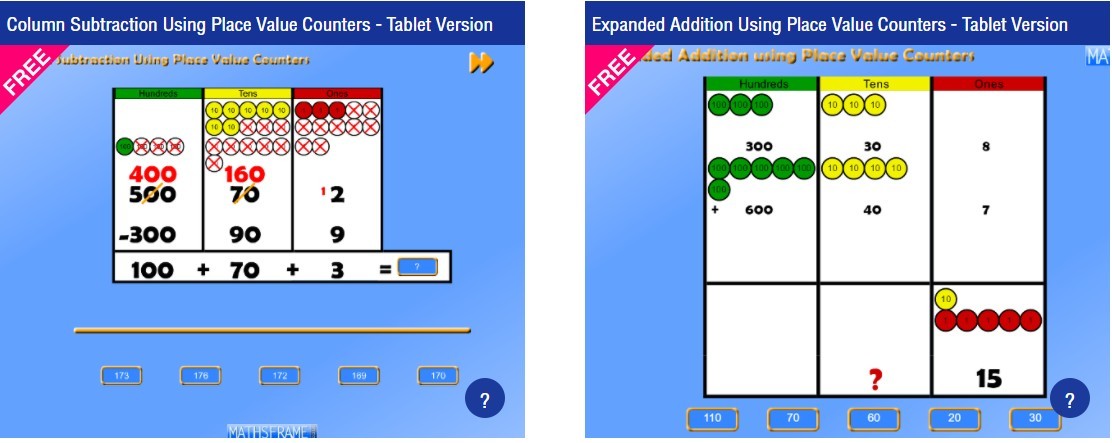
Many of the games and activities on Mathsframe are free and come with a range of support and challenge.
I particularly like the ones shown above for children who are still building conceptual understanding (but also for those who have learnt a method but don’t actually understand what they are doing).
As a paid member, you also have access to assessments and variations of problem solving questions.
3. Prodigy Game

My class would play prodigy all day long if I let them. It’s free and takes minutes to set up. As a teacher, all you need to do is set tasks regularly to match what the children are learning in class or to revisit prior learning.
Each pupil has a login and they have to solve maths problems to move through the game.
They can meet other people from their class but not anyone from the outside world so it’s also pretty safe. It’s great for home learning; the only drawback is getting them to stop playing at the end of a session.
Other resources to build Maths fluency at KS2
For those without internet access to interactive online games, we’re always adding to our collection of maths games blogs. Choose any of these for maths games KS2 will get the most out of, or if you’re looking for support specifically to develop fluency in times tables then these times tables games are ideal.
Another favourite for building fluency in maths is Times Tables Rockstars which will give your pupils the confidence, speed and accuracy they need to fly through the Year 4 Multiplication Tables Check.
How I teach mathematical fluency to Year 3 and Year 4
So, after seeing so many approaches to developing fluency and number sense, what have I done in my own practice? The answer is simple – I’ve shared it and used it.
In Year 4 where I am based, the team were reflecting on the ‘use it or lose it’ issue that arises when an area of maths is mastered but not returned to.
So after sharing the ideas I have seen we incorporated our favourite bits into one model:
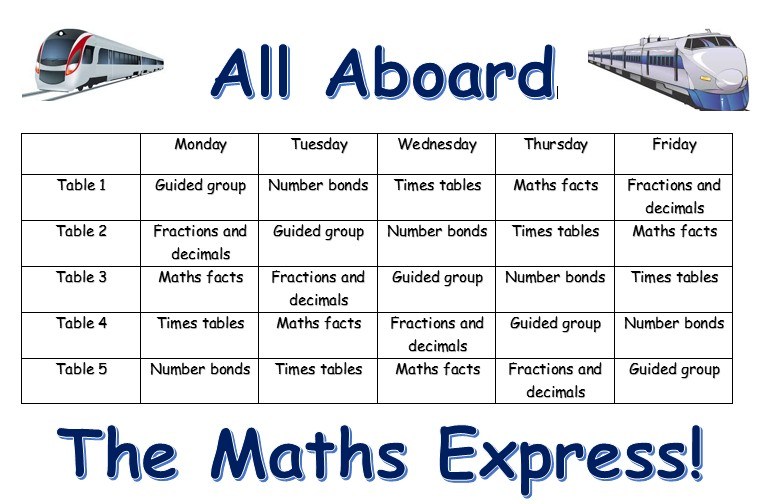
Sticking with the carousel model, each day pupils practise the mathematical concept or fluency they are focusing on in addition to the fluency focus from previous terms until they’re giving accurate answers every time.
On one day they have a guided group with an adult and if need be the teacher pre-teaches or works with small groups of pupils who haven’t grasped concepts in that day’s Maths lesson.
One session is on laptops and the ‘maths facts’ session is using the weekly repetition example shown above.
Having just read Clare Sealy’s amazing blog on teaching telling the time, we are now thinking about swapping one of the activities to one based on fluency in reading time.
As Clare quite rightly said, we all tear our hair out when trying to teach time but only do so once a year. Maths Express is accompanied by using ‘Fluent in Five’ at the beginning of each Maths lesson or as a morning challenge when children arrive at school.
Why have we called it Maths Express? The Year 6 teacher and Maths Lead at Brockhurst had given this name to her sessions and we liked the sound of it. Some of the boys in our year group are mad on trains so we decided to use it too.
The children love the sessions and one child commented, ‘I know why it’s called Maths Express. We are all on the train together heading in the same direction and we want to get to the same place.’ I couldn’t have put it any better myself.
READ MORE:
- What is Maths Mastery and Teaching for Mastery?
- Maths mastery resources to support your maths teaching
- Ultimate KS2 Checklist Of 33 Mental Maths Strategies
How Third Space Learning’s online tuition supports the development of maths fluency
Each lesson begins with a recap of prior knowledge that links to the current lesson. Skye, the AI tutor, uses real world examples and effective questioning to introduce and develop the pupil’s knowledge of the topic. The pupil and Skye then work together on procedural fluency for the lesson objective, building towards more complex problems as a pupil masters the concept. This process allows Skye to address misconceptions as they arise.
DO YOU HAVE STUDENTS WHO NEED MORE SUPPORT IN MATHS?
Skye – our AI maths tutor built by teachers – gives students personalised one-to-one lessons that address learning gaps and build confidence.
Since 2013 we’ve taught over 2 million hours of maths lessons to more than 170,000 students to help them become fluent, able mathematicians.
Explore our AI maths tutoring or find out about an online maths tutor for your school.



![Fluent in Five Arithmetic Pack: Years 3 to 6 [Weeks 1 to 6]](https://thirdspacelearning.com/wp-content/uploads/2018/03/Fluent-in-Five-Weeks-1-6-1.png)

